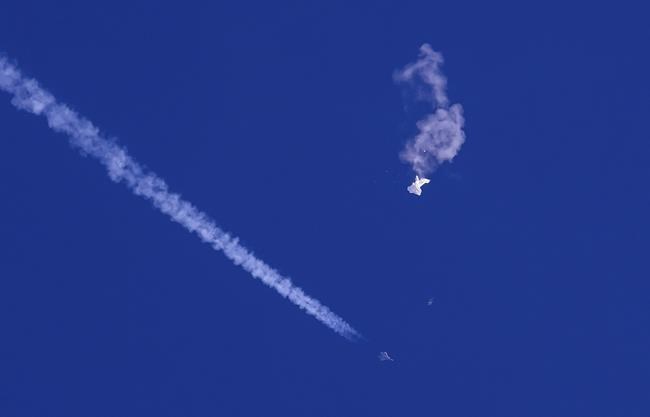OTTAWA — Canadians were left with more questions than answers on Friday as a pair of senior military officers briefed a parliamentary committee about the slew of objects shot down over North American skies in recent weeks.
Among the unanswered questions were why China sent a suspected spy balloon into Canadian and American airspace and what it accomplished, as well as the identity of three objects downed by American fighter jets last weekend.
That includes a suspected balloon that was shot down over central Yukon last Saturday, and another object over Lake Huron on Sunday.
"This is why we want to have an opportunity to capture these objects, to use that term," said Lt.-Gen. Alain Pelletier, the deputy commander of the joint U.S.-Canadian air surveillance and defence command known as Norad.
"To analyze them to see whether it's a balloon or some other type of object, let's say a type of drone. And in order to get a better understanding of their capacity and origin as well."
Friday's hearing was the first opportunity for parliamentarians to question military leaders about the Chinese balloon and three other objects that have left Canadians and Americans scanning the skies for weeks.
The two military officers revealed that the suspected Chinese spy balloon shot down off the coast of South Carolina on Feb. 4 passed near several military bases and through "radar gaps" during its flight over Canada.
Pelletier confirmed the balloon, which was first detected entering Alaskan airspace on Jan. 28, travelled through Canada on Jan. 30 and 31 before re-entering the U.S., where its presence was publicly revealed.
The balloon travelled from Alaska into the Yukon and south into central British Columbia, between the border with Alberta and the Pacific Coast.
"The high-altitude surveillance balloon of (the People's Republic of China) came in proximity to some of the Canadian bases, but I cannot speak of the actual response of those Canadian bases," Pelletier added.
Maj.-Gen. Paul Prevost, head of the military's strategic joint staff, later downplayed any potential security breach, saying: "There was no Canadian Forces infrastructure of significance along its path."
However, both Pelletier and Prevost also told the committee that the balloon's real capabilities won't be fully understood until wreckage recovered by U.S. authorities has been fully analyzed.
The two senior officers also offered only speculation about why China, which has denied any spying, would opt to send a high-altitude balloon into North American airspace when it has satellites.
"China is trying to figure out our limits, and this was an unwanted, unauthorized breach of our sovereignty," Prevost said. "They're probably wanting to know how tolerant we are to that."
U.S. military officials have said that at least four other Chinese balloons violated American airspace since 2019, some of which were only learned about after the fact.
U.S. Gen. Glen VanHerck, the commander of Norad, has said the balloons were able to avoid detection because of a "domain awareness gap" that has been at least partially narrowed by recalibrating the defence system's radars.
"Some of that gap has been addressed by fine-tuning the radars and making them more sensitive to things that are high, slow and small," U.S. National Security Council spokesman John Kirby said on Friday.
"If there needs to be more resources applied to this particular challenge, then that's certainly a conversation worth having."
Pelletier and Prevost were also grilled about the other three objects taken down last weekend over Alaska, the Yukon and Lake Huron, and whether Canada's aging CF-18s were capable of destroying them.
Kirby refused to speculate Friday on a possible link between the object in Yukon and a hobby group in Illinois, insisting the only real answers lie with whatever wreckage remains of the objects.
Pelletier and Prevost did not offer much in the way of additional details, though Pelletier did describe the object shot down in Yukon as a "suspected balloon." Like Kirby, they emphasized the importance of finding those objects.
Yet the likelihood of a successful search appeared to be waning.
The RCMP announced Thursday that it has suspended its search in Lake Huron, citing deteriorating weather conditions and a low probability of success.
Prevost warned recovery efforts in Yukon were like trying to find "a needle in a snowbank."
"The one in Yukon specifically landed in mountainous terrain with about a metre to a metre-and-a-half of snow," he said. "Picture an object falling from 20,000 feet into that snow."
Still, whatever the three objects were, Prevost said, "what we know is those objects were unauthorized and unwanted."
Committee members also heard that timing was the main factor in the decision to have an American F-22 destroy the suspected balloon over Yukon. Prevost said two CF-18s were scrambled, but still five minutes away when the shot was taken.
"The F-18s had been scrambled," he said. "The F-18s had a good chance of taking an engagement there. But we liked to go with the first opportunity, which was the F-22 just as (the object) crossed the border."
Some have questioned whether Canada's aging fighter jets had the capability to destroy a small, slow-moving balloon at high altitude, particularly as their combat sensors and weapons are outdated and have yet to be upgraded.
Prevost said the CF-18s were carrying an older version of the type of missile that the F-22 used to destroy the balloon over Yukon, and that tests would have been conducted before a shot was taken.
"The F-18, we thought on that object, would have been able to attempt it," he said.
This report by The Canadian Press was first published Feb. 17, 2023.
— With files from James McCarten in Washington, D.C.
Lee Berthiaume, The Canadian Press
Note to readers: This is a corrected story. A previous version erroneously attributed remarks that the balloon did not pass over particularly sensitive sites in Canada to Norad deputy commander Lt.-Gen. Alain Pelletier.



